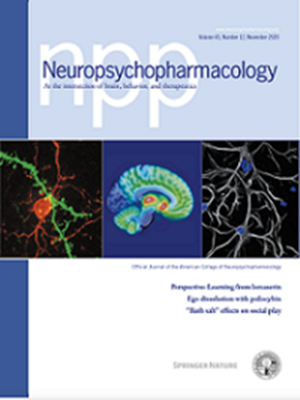Metabolomic profiling of cannabis use and cannabis intoxication in humans
IF 6.6
1区 医学
Q1 NEUROSCIENCES
引用次数: 0
Abstract
Acute intoxication from Δ9-tetrahydrocannabinol (THC, the primary active ingredient of cannabis) can lead to neurocognitive impairment and interference with day-to-day operations, such as driving. Present evaluations of THC-induced impairment in legal settings rely on biological drug tests that solely establish cannabis use, rather than cannabis impairment. The current study evaluated the metabolome in blood collected from occasional and chronic cannabis users (N = 35) at baseline and following treatments with cannabis (300 μg/kg THC) and placebo, with the aim to identify unique metabolic alterations that are associated with acute cannabis intoxication and cannabis use frequency. Blood samples were collected at baseline and repeatedly during 70 min after treatment. Sustained attention performance and ratings of subjective high were taken twice within 40 min after treatment. Metabolomic fingerprints of occasional and chronic cannabis users were distinctly different at baseline, when both groups were not intoxicated. A total of 14 metabolites, mainly related to endocannabinoid and amino acid metabolism, were identified that distinguished chronic from occasional cannabis users and that yielded a discriminant analysis model with an 80% classification rate (95% CI: 61–91%). Distinct metabolomic fingerprints were found for occasional cannabis users who, in contrast to chronic cannabis users, showed attentional impairment and elevated ratings of subjective high during cannabis intoxication. These included increments in organic acids, β-hydroxybutyrate and second messenger ceramides. The current study demonstrates the feasibility of the metabolomics approach to identify metabolic changes that are specific to the neurocognitive state of cannabis intoxication and to the history of cannabis use.

人类大麻使用和大麻中毒的代谢组学分析。
Δ9-tetrahydrocannabinol(四氢大麻酚,大麻的主要活性成分)的急性中毒可导致神经认知障碍和干扰日常操作,如驾驶。目前在法律环境中对四氢大麻酚引起的损害的评估依赖于生物药物测试,这些测试仅确定大麻使用情况,而不是大麻损害。目前的研究评估了偶尔和慢性大麻使用者(N = 35)在基线和使用大麻(300 μg/kg THC)和安慰剂治疗后采集的血液中的代谢组,目的是确定与急性大麻中毒和大麻使用频率相关的独特代谢改变。在基线和治疗后70分钟内反复采集血样。治疗后40 min内进行2次持续注意表现和主观高分评分。偶尔和慢性大麻使用者的代谢组指纹在基线时明显不同,当两组都没有醉酒。共鉴定出14种代谢物,主要与内源性大麻素和氨基酸代谢有关,可区分慢性大麻使用者和偶尔大麻使用者,并建立了判别分析模型,分类率为80% (95% CI: 61-91%)。在偶尔吸食大麻的人身上发现了明显的代谢组指纹,与长期吸食大麻的人相比,他们在大麻中毒期间表现出注意力障碍和主观高评级的提高。其中包括有机酸、β-羟基丁酸和第二信使神经酰胺的增加。目前的研究证明了代谢组学方法识别大麻中毒的神经认知状态和大麻使用史特有的代谢变化的可行性。
本文章由计算机程序翻译,如有差异,请以英文原文为准。
求助全文
约1分钟内获得全文
求助全文
来源期刊

Neuropsychopharmacology
医学-精神病学
CiteScore
15.00
自引率
2.60%
发文量
240
审稿时长
2 months
期刊介绍:
Neuropsychopharmacology is a reputable international scientific journal that serves as the official publication of the American College of Neuropsychopharmacology (ACNP). The journal's primary focus is on research that enhances our knowledge of the brain and behavior, with a particular emphasis on the molecular, cellular, physiological, and psychological aspects of substances that affect the central nervous system (CNS). It also aims to identify new molecular targets for the development of future drugs.
The journal prioritizes original research reports, but it also welcomes mini-reviews and perspectives, which are often solicited by the editorial office. These types of articles provide valuable insights and syntheses of current research trends and future directions in the field of neuroscience and pharmacology.
 求助内容:
求助内容: 应助结果提醒方式:
应助结果提醒方式:


